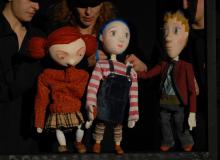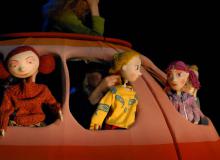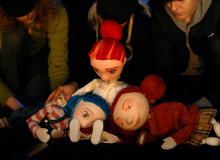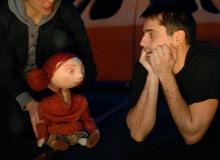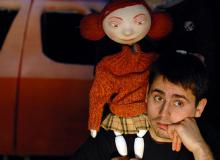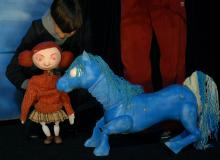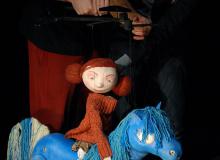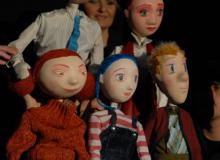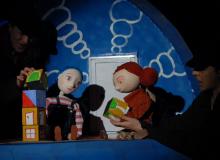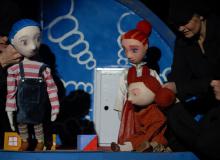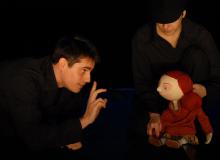WHO IS LAURETTE?
 WHO IS LAURETTE?
WHO IS LAURETTE?
Translation: Iva Brdar
Theatrical adaptation: Мilena Depolo
Director: Katarina Petrović
Set, costume and puppet designer: Filip Jevtić
Composer: Vladimir Petričević
Puppet technology: Goran Balančević
Expert Consultant for Puppet Animation: Tatjana Stanković
Laurette: Јelena Ilić
Mother, Claire, Marry, Parent: Тatjana Stanković
Еlsa, Jean, Teacher: Аleksandra Andjelković
Pony, Sebastian, Parent II: Мiloš Andjelković
Dad, Philip, Riding Instructor, Parent III: Goran Balančević
Date of premiere: 27 March 2009
Duration: 50'
Аuthor: Florence Cadier / Milena Depolo
Stage: Children Stage

The puppet show “Who is Laurette?” is based on the children’s story book written by the French writer Florence Cadier and translated to many languages. Thanks to the enthusiastic enterprise of the publishing house “Baobab”, it is available also in our language. Iva Brdar translated the book from the French language, Milena Depolo adapted the story for the stage and Katarina A. Petrović directed it. “Who is Laurette?” is a play about a girl with Down syndrome who invites the young audience to change their view of children who are different. Laurette’s story about fitting into the mainstream school against the odds shows how she easily manages to live the moments of joy while growing up due to her pure experience of the surrounding world.
ABOUT THE DIRECTOR
Katarina A. Petrović was born in Belgrade on 24 May 1979.
She lived and was educated in Cape Town, South African Republic, until she started the studies of film production at the University in Oakland, New Zealand. She graduated in stage direction in Belgrade, in the class of Professors Nikita Milivojević and Anita Mančić.
Performances:
“The Crime on Goat Island”, Ugo Betti
”The Love of Don Perlimplín and Belisa in His Garden“, F. G. Lorca
She currently lives and works in Belgrade.
ABOUT THE PERFORMANCE
“When I was six or seven years old, University Professor Miguel Garcia Melero asked me: “Do you know that you suffer from Down’s syndrome?“ I answered affirmatively although I had no idea what it was. He noticed that and started to explain to me what it was all about. When he finished, I asked him, alarmed: “Professor, am I feeble-minded?” He said I was not. Then I asked: “Will I be able to continue learning?“ He said: “Of course!“
Pablo Pineda, MD
Down’s syndrome is a form of chromosomal disorder caused by the presence of an extra copy of chromosome 21. Its symptoms are specific facial features and intellectual disability as an unfailing indicator of this syndrome (IQ 40-50, although there are also data about IQ 25-80). It was first described in 1866 by Langdon Down who had a child with this syndrome, but as late as in 1957 it was established that its cause was trisomy.
The frequency of this syndrome in human population is 1 per 700 live births.
“Who is Laurette?” is a play about a girl with Down syndrome who invites the young audience to change their view of children who are different. Laurette’s story has its moments of pain and shows difficulties with fitting into the mainstream school, but due to her pure experience of the surrounding world, unburdened with trivial matters, and even due to her sense of humour,
Laurette manages easily to live the moments of joy while growing up.
It is a challenge to deal with a topic such as Down syndrome in a society that is still unsure where and how to position such diversity of persons with special needs.
“I do not look like other girls. I know I am different because people in the street stare at me. When I look at myself in the mirror, I see that my eyes are slanted and I’ve got a weird smile. Sometimes my smile remains hidden in my heart.”
First of all, there is a physical, visual difference that children with Down syndrome have to deal with in order to integrate into society. They are faced with something that is not their perception of beauty, but often an imposed generally accepted conception. In order to avoid this generally accepted conception that should not encumber children who look different because of genetics, we have lifted this burden from the play adding imagination with the help of puppets as protagonists of this story.
Although children with Down syndrome, like everybody else, are “disabled” in some aspects of everyday functioning, with all their perfection and imperfection, with their virtues and defects, if properly worked with, it will be possible to identify certain activities they pursue with great commitment and often very successfully. Laurette is skilful in riding a pony. In this story she gets her recognition and becomes accepted by her mainstream school class in quite an unassuming and spontaneous manner, through her love of riding.
"Why are we different from other children?” - I ask my mother. And what if, in fact, we are different?!” - The mother answers, laughing. Not relying all the time on the objective perception of the world, I have tried to present Laurette’s world in which it is unnecessary to seek support in the collective reality, and with a single motive - to draw attention, through theatre, to this aspect of our social existence. From the universal aspect, we are beings with a herd instinct, we need each other, and isn’t every one of us different from everybody else, or don’t we often feel that way even without drastic genetic differences?
From the aspect of drama, the story has been broadened by introducing the character of Pony, to reveal through their relationship Laurette’s inner world, which is very rich, although the people in her environment refuse to see it. At the beginning, spending time with Pony represents Laurette’s haven and escape from the real world around her but eventually it becomes a tool she uses in her struggle to become part of that reality.
The importance of this project, which is in fact a pioneering project with a topic rare in this country, is to further involve children in cultural life by offering them a kind of committed theatre. We should not offer them only fairy tales when it is possible to show a real-life story in an interesting and attractive manner; at first sight it might not be pleasant, unless we teach them to recognise beauty and human values in everything. Children should also be made into active factors of society, not underestimating them but giving them significance, because they too can change their seemingly small world, just as we change our, apparently, big world.
Katarina A. Petrović
“WHO IS LAURETTE?” OR “WHO AM I?”
Some people wear glasses, some have braces, some people have big ears, some are clever and beautiful, some just clever… Some just beautiful… Some are dark and some are blond…
Some people have slanting eyes and a round face. And they slightly waddle when they walk… They have a characteristic smile and like to sit with their legs crossed.
We are all different, but we all wish and have the right to associate with others and be heard. Because, whatever we look like, we are all part of the same world, and the more diversities we notice and accept, the more we will learn about it. No person’s perception of the world is less valuable than that of others just because it is different from the perception of some group. Moreover, perhaps we shall have the opportunity to learn from that very person something we did not know.
The main intention of the play “Who is Laurette?“ is to show that diversity should not be treated as a flaw, but as a quality. That is the reason why we do not treat Down syndrome as a “disease” (which is a frequent mistake people make, even the highly-educated ones), but as any other characteristic.
We have also tried to bring our Laurette and her bewilderment and dilemmas closer to each and every one of our little spectators, and even their parents and teachers. That is why, along with the question “Who is Laurette!”, we give our audience a task, not a simple one, to try to answer who they really are...
Milena Depolo
ABOUT THE AUTHOR
Florence Cadier lives in Boulogne with her two children, Bastien and Valentine. She wrote her first stories for them.
When she met children like Laurette, she wished to write this story.





